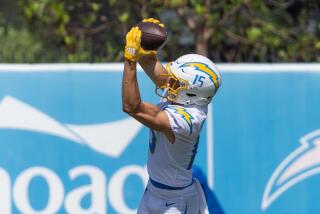Forget the Firsts; It’s Follow-Ups That Make the Difference in NFL Draft
- Share via
It has been happening for years, and it will happen again Sunday.
National Football League teams will roll out the red carpets, blow the bugles and herald the arrival of a new No. 1 draft choice the same way the multitudes bring in the new year at Times Square. Let the confetti fly.
Fans, of course, will argue the merits and demerits of the man the hometown heroes have chosen to wear this crown of new hope. Let the controversy fly.
Naturally, each team will hustle its newest phenom onto a plane and hurry him into town to face a blitz of note pads and cameras. Let the questions fly.
Listen for the click that echoes across the nation when the last No. 1 is picked and televisions switch to golf or bowling or a retired jock fishing with a retired announcer.
All of this happens because there is something special about being a No. 1.
But how special?
What of these other draftees?
What about Rounds 2, 3 and 4, for example?
How might the Charger draft have been covered in 1973?
CHARGERS DRAFT HEISMAN WINNER
Shades of Keith Lincoln and Paul Lowe, the Chargers used their No. 1 pick to draft Heisman Trophy winner Johnny Rodgers from Nebraska. He figures to be the running back for years to come.
Having traded the second-round pick and the first pick in the third round, the Chargers used their second third-round pick on a quarterback from Oregon named Dan Fouts. He figures to be around for weeks to come.
History tells us Rodgers went first to Canada, then came back to the Chargers for a cameo in the twilight of a virtually non-existent NFL career. The other fella put in a good year or two or 15 before he went into broadcasting.
The message here is that there is more to the NFL draft than that veneer on the surface. Much more.
The first round is like an 18-inch putt. You’re not going to miss very often, which makes it extremely embarrassing when you do. The Chargers’ only whiff in the past few years was Mossy Cade in 1984.
All the picks beyond the first round do is build you a football team. That’s all.
And there can be jewels down there below the glitter and gloss at the top.
Second-round draftees include Fred Smerlas, Vance Johnson, Rulon Jones, Mark Duper, Dwight Stephenson, Mark Gastineau, Wesley Walker, Mike Singletary, Nolan Cromwell, Henry Ellard, Randall Cunningham and Neil Lomax. Not a bad bunch considering all were passed on one time through.
Third-round draftees include Henry Marshall, Mike Merriweather, Dave Duerson, Doug Cosbie, Danny White, Jackie Slater and Joe Bostic. Not bad for being passed on twice through.
And fourth-round draftees include Mark Bavaro, Harry Carson and Roy Green. Not bad for being passed on thrice through.
Notice how the quantity of quality thins from one round to the next?
We never said it was easy.
The Raiders have been particularly successful in those second through fourth rounds, picking up Howie Long, Matt Millen, Bill Pickel, Vann McElroy, Mickey Marvin and Greg Townsend.
These are the rounds, more so than the first, that can make or break a football team.
“You have to be very careful in the draft room,” said Steve Ortmayer, the Chargers’ director of football operations and head draft guru. “You can’t let down after the first pick. The second round rolls around much faster than you think, and it’s much, much, much harder to make the second pick than it is the first.”
How hard?
“A lot of people consider the best drafter to be (Washington’s) Bobby Beathard,” Ortmayer said. “The Redskins’ record for second-round picks in the ‘80s is unbelievable. They have none. They’ve missed on every one.”
The problem is that there is an exponential expansion of pre-draft possibilities following the selection of the first player drafted. The Chargers, picking eighth in the first round, can probably narrow the possible players available to a half dozen at the most. However, the range for a pre-draft projection of players available in the Chargers’ second-round slot might be two or three dozen. And this range multiplies with each round.
“It gets tougher and tougher to know what’s going to be there when it gets to you,” Ortmayer said. “It gets tougher and tougher to know what scenario will be set up. Yet these choices are just as important to us as the top pick. We feel it’s very important to put five young players on our football team, and we don’t care if they come from the first round or the seventh round.”
A year ago, the Chargers managed to put three young players on the club in the fourth round alone, getting offensive lineman David Richards with their pick and defensive lineman Joe Campbell and offensive lineman Stacy Searels with picks acquired in trades. What’s more, wide receiver Quinn Early was selected in the third round.
“We feel those rounds were productive,” Ortmayer said. “And remember that we got Mark Vlasic in the fourth round the year before.”
Thus, those may be the rounds to watch come Sunday . . . because those may be the players to watch come September. If the Chargers are going to make an upward move, those players had better be there come September.
More to Read
Go beyond the scoreboard
Get the latest on L.A.'s teams in the daily Sports Report newsletter.
You may occasionally receive promotional content from the Los Angeles Times.










